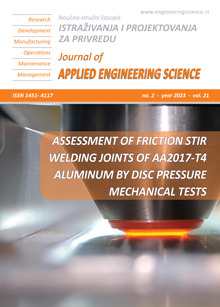BOND STRENGTH PREDICTION OF UHPC–NSC INTERFACE
Abstract
The application of ultra-high-performance concrete (UHPC) on top of normal-strength concrete (NSC) is a practical rehabilitation approach to maintaining degraded and damaged concrete members. However, a successful repair operation and consequent adequate performance are very much dependent on the ability of the interface between UHPC and NSC to present a superior performance of bonding under various surface conditions. Consequently, predicting the strength of the bond at the interface joining the existing NSC and the newly placed overlaying UHPC – with sufficient certainty – has become a vital and required step in assessing and maintaining UHPC rehabilitated NSC structural elements. In this work, Artificial Neural Network (ANN as well as Gene Expression Programming (GEP methods are utilized to predict the bond strength between the overlaying UHPC and the substrate NSC using a comprehensive database set consisting of 264 experimental data points gathered from the literature. A parametric ANN analysis is performed to examine and assess the effect of each parameter on the interfacial bond strength. The following five factors are identified as key parameters through the GEP and ANN analyses: curing method, age of UHPC, the compressive strength of NSC, interfacial surface treatment, and moisture conditions. The developed ANN and GEP models have good accuracy and closer predictions of the bond strength of the slant shear test and the splitting tensile strength with root mean square error (RMSE) values of 5.0, 4.3, and coefficient of variation (COV) values of 37%, 24%, respectively.
References
Zhang, Y., Zhu, P., Liao, Z. and Wang, L., (2020). Interfacial bond properties between normal strength concrete substrate and ultra-high performance concrete as a repair material. Construction and Building Materials, 235, p.117431.
Green, M., Bisby, L., Beaudoin, Y. and Labossière, P., (2000). Effect of freeze-thaw cycles on the bond durability between fibre reinforced polymer plate reinforcement and concrete. Canadian Journal of Civil Engineering, 27(5), pp.949-959.
Sudhakumar, J. (2001). “Methods of repairing concrete structures.” In Proc.,26th Conf. on Our World in Concrete and Structures, 605–612.Singapore: CI-Premier Pte.
Smoak, G. 2002. Guide to concrete repair. The Minerva Group, Inc.
Farouk, A. and Jinsong, Z., (2022). Prediction of Interface Bond Strength between Ultra-High-Performance Concrete UHPC and Normal Strength Concrete (NSC) Using a Machine Learning Approach. Arabian Journal for Science and Engineering, 47(4), pp.5337-5363.
Pishro, A. A., Feng, X., Ping, Y., Dengshi, H., & Shirazinejad, R. S. (2020). Comprehensive equation of local bond stress between UHPC and reinforcing steel bars. Construction and Building Materials, 262, 119942.
Graybeal, B. and Tanesi, J., 2007. Durability of an Ultrahigh-Performance Concrete. Journal of Materials in Civil Engineering, 19(10), pp.848-854. Doi: https://doi.org/10.1016/j.conbuildmat.2020.119942
Wu, Z., Khayat, K. H., & Shi, C. (2019). Changes in rheology and mechanical properties of ultra-high performance concrete with silica fume content. Cement and Concrete Research, 123, 105786.
Carbonell Muñoz, M., Harris, D., Ahlborn, T. and Froster, D., (2014). Bond Performance between Ultrahigh-Performance Concrete and Normal-Strength Concrete. Journal of Materials in Civil Engineering, 26(8), p.04014031.
Yuan, S., Liu, Z., Tong, T. and Fu, C., (2022). Bond Behaviors between UHPC and Normal-Strength Concrete: Experimental Investigation and Database Construction. Journal of Materials in Civil Engineering, 34(1).
Du, C., Liu, X., Liu, Y. and Tong, T., (2021). Prediction of the Interface Shear Strength between Ultra-High-Performance Concrete and Normal Concrete Using Artificial Neural Networks. Materials, 14(19), p.5707.
Valikhani, A., Jahromi, A., Mantawy, I. and Azizinamini, A., (2020). Experimental evaluation of concrete-to-UHPC bond strength with correlation to surface roughness for repair application. Construction and Building Materials, 238, p.117753.
Baharuddin, N., Mohamed Nazri, F., Putra Jaya, R. and Abu Bakar, B., (2016). Evaluation of bond strength between fire-damaged normal concrete substance and ultra-high-performance fiber-reinforced concrete as a repair material. World Journal of Engineering, 13(5), pp.461-466.
Jafarinejad, S., Rabiee, A. and Shekarchi, M., (2019). Experimental investigation on the bond strength between Ultra high strength Fiber Reinforced Cementitious Mortar & conventional concrete. Construction and Building Materials, 229, p.116814.
Abo Sabah, S., Hassan, M., Muhamad Bunnori, N. and Megat Johari, M., (2019). Bond strength of the interface between normal concrete substrate and GUSMRC repair material overlay. Construction and Building Materials, 216, pp.261-271
Tayeh, B.A., Bakar, B.A., Johari, M.M. and Voo, Y.L., (2012). Mechanical and permeability properties of the interface between normal concrete substrate and ultra-high-performance fiber concrete overlay. Construction and building materials, 36, pp.538-548.
Abo Sabah, S.H., Zainal, N.L., Muhamad Bunnori, N., Megat Johari, M.A. and Hassan, M.H., (2019). Interfacial behavior between normal substrate and green ultra‐high‐performance fiber‐reinforced concrete under elevated temperatures. Structural concrete, 20(6), pp.1896-1908.
Hong, S.G. and Kang, S.H., (2015). Effect of surface preparation and curing method on bond strength between UHPC and normal strength concrete. In IABSE Conference: Structural Engineering: Providing Solutions to Global Challenges, Geneva, Switzerland, September 2015 (pp. 1537-1543).
Almomani, Y., Tarawneh, A., Alawadi, R., Taqieddin, Z.N., Jweihan, Y., and Saleh, E., (2022). PREDICTIVE MODELS OF BEHAVIOR AND CAPACITY OF FRP REINFORCED CONCRETE COLUMNS. Journal of Applied Engineering Science, Accepted.

